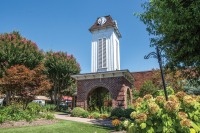Requiem for a heavyweight
The eastern hemlock has long been one of my favorite trees. Like many people reading this column, my wife, Elizabeth, and I have a number of very large specimens growing on our property, especially alongside a creek that traverses the cove we live in. And, of course, we’re very concerned about losing these wonderful trees to the hemlock woolly adelgid infestation that is currently ravaging the southern mountains. All of our hemlocks show signs of the infestation, and we will hate to lose them. This column, then, is sort of an ode to the hemlock.
As Arthur Stupka, the long-time naturalist in the Great Smoky Mountains National Park, once observed, “Eastern hemlock lacks the stiffness so characteristic of some of the other cone-bearing species.” In addition, it frequents some of the few remaining truly wild areas in the mountains. In my experience, any place that you encounter giant hemlocks in abundance is sure to be an exciting place to explore.
Eastern hemlock — or Canada hemlock, as it is sometimes called — reaches into the high-elevation spruce-fir country, but for the most part it’s found along ridges between 3,500-5,000 feet or on north slopes and in ravines or alongside creeks in the lower elevations. Sometimes you will encounter monster hemlocks almost 100-feet tall with circumferences approaching 20 feet.
A curious characteristic of this species is that its uppermost tip assumes a graceful weeping habit, often bending so as to make a right angle with the vertical trunk. The great-crested flycatcher takes advantage of this natural perch more than any other bird species as a place from which to sound its calls and hawk insects.
Hemlocks love shade, rocks, and slopes. Sometimes you will find them growing in steep ravines straddling boulders. They are normally found scattered among other hardwoods. But pure stands of eastern hemlock are sometimes encountered in remote sections of the Great Smokies (especially in the Cataloochee area), Joyce Kilmer Memorial Forest, Linville Gorge, the headwaters region of the Pigeon River, and elsewhere.
There are two native species of hemlock in the southern mountains: eastern hemlock (Tsuga canadensis), recognized by its flattened, tapered needles that appear to extend in a flat plane from the branch stems; and Carolina hemlock (Tsuga caroliniana), an uncommon species of rocky woods, dry slopes, bluffs, and cliffs with flat needles that are not tapered and spread from the branch stems in all directions. There is a stand of huge Carolina hemlock in the Linville Falls area of the Blue Ridge Parkway between mileposts 316 and 317, as well as a stand on United States Forest Service property near Highlands. It is my understanding that the Carolina hemlock is also susceptible to the adelgid infestation.
Related Items
Long-lived eastern hemlocks are said to approach 1,000 years of age. A heavy seed crop is usually followed by two or three years of light seed production. Red squirrels are highly dependent on hemlock seeds, and their populations will no doubt decline once the hemlocks are a thing of the past. The early settlers learned from the Cherokees that the high tannin content of the bark made it a useful curative for burns and sores. The bark was also used for tanning leather.
In his A Natural History of Trees (1950), Donald Peattie captured the essence of the hemlock in words:
“In the grand, high places of the southern mountains, hemlock soars above the rest of the forest, rising like a church spire — like numberless spires as far as the eye can see — through the blue haze .... Hemlock serves us best [when] rooted in its tranquil, age-old stations. Approaching such a noble tree, you think it dark, almost black, because the needles on the upper side are indeed a lustrous deep blue-green. Yet when you lunch on the rock that is almost sure to be found at its feet, or settle your back into the buttresses of the bole and look up under the boughs, their shade seems silvery, since the underside of each needle is whitened by two lines. Soon even talk of the tree itself is silenced by it, and you fall to listening. When the wind lifts up the hemlock’s voice, it is no roaring like the pine’s, no keening like the spruce’s. The hemlock whistles softly to itself. It raises its long, limber boughs and lets them drop again with a sign, not sorrowful, but letting fall tranquility upon us.”
George Ellison wrote the biographical introductions for the reissues of two Appalachian classics: Horace Kephart’s Our Southern Highlanders and James Mooney’s History, Myths, and Sacred Formulas of the Cherokees. In June 2005, a selection of his Back Then columns was published by The History Press in Charleston as Mountain Passages: Natural and Cultural History of Western North Carolina and the Great Smoky Mountains. Readers can contact him at P.O. Box 1262, Bryson City, N.C., 28713, or at This email address is being protected from spambots. You need JavaScript enabled to view it..









